List of Polish monarchs
Poland was ruled at various times either by dukes and princes (the 10th–14th century) or by kings (the 11th–18th centuries). During the latter period, a tradition of free election of monarchs made it a uniquely electable position in Europe (16th–18th centuries).
| Monarchy of Poland | |
|---|---|
 | |
 Stanisław II Augustus | |
| Details | |
| Style | Royal Majesty (HRM)[1] Wasza Królewska Mość Serene Reigning Majesty Jaśnie Panujący Mości[2] Grace (HG) Wasza Miłość Highness (HH) Wasza Wysokość |
| First monarch | Mieszko I |
| Last monarch | Stanisław II Augustus |
| Formation | ca. 960 (First Christian Monarch) |
| Abolition | 7 January 1795 |
| Residence | Wawel Castle Warsaw Castle Wilanów Palace |
| Appointer | Hereditary Elective[3] |
| Pretender(s) | none Ruediger, Margrave of Meissen (disputed) Alexander, Margrave of Meissen (disputed) |
The first known Polish ruler is Duke Mieszko I[4] who adopted Christianity under the authority of Rome in the year 966. He was succeeded by his son, Bolesław I the Brave, who greatly expanded the boundaries of the Polish state and ruled as the first king in 1025. The following centuries gave rise to the mighty Piast dynasty, consisting of both kings such as Mieszko II Lambert, Przemysł II or Władysław I the Elbow-high and dukes like Bolesław III Wrymouth. The dynasty ceased to exist with the death of Casimir III the Great in 1370. In the same year, the Capetian House of Anjou became the ruling house with Louis I as king of both Poland and Hungary. His daughter, Jadwiga, later married Jogaila, the pagan Grand Duke of Lithuania, who in 1386 was baptized and crowned as Władysław II Jagiełło, thus creating the Jagiellonian dynasty and a personal union between Poland and Lithuania.
During the reign of Casimir IV Jagiellon and Sigismund I the Old, culture flourished and cities developed. This era of progress, also known as the Polish Renaissance, continued until the Union of Lublin under Sigismund II Augustus, which unofficially marked the end of the Polish Golden Age. After the death of last Jagiellonian king, the united Polish–Lithuanian Commonwealth became an elective monarchy with mostly foreigners elected as monarchs such as Henry III of France, who witnessed the introduction of Golden Liberty and Stephen Báthory, a great military commander who strengthened the nation. The meaningful rule of the Vasa dynasty initially expanded the Commonwealth, developing the arts and crafts, as well as trade and commerce. King Sigismund III Vasa, a talented but somewhat despotic ruler, involved the country in many wars, which subsequently resulted in the successful capture of Moscow and loss of Livonia to Sweden. His son, Władysław IV Vasa, fiercely defended the Commonwealth's borders and continued the policy of his father until death, unlike John II Casimir whose tragic rule forced his abdication.
The election of John III Sobieski to the Polish throne was a great success. His brilliant military tactics led to the victory at Vienna in 1683 and partial recapture of land from the Ottoman Empire. However, the years that followed were not as successful; the long and ineffective rule of the Wettin dynasty (Augustus II the Strong and Augustus III) placed the Commonwealth under the influence of Saxony and the Russian Empire. Additional feuds with rebelled nobility (szlachta) and most notably Stanisław I Leszczyński and France diminished the influence of Poland-Lithuania in the region. This led to the partitions that occurred under King Stanisław II Augustus, yet another enlightened, but ineffective monarch. The Duchy of Warsaw existed from 1807 to 1815. The last sovereign was Frederick Augustus I as Duke of Warsaw, who throughout his political career attempted at rehabilitating the Polish state. After Poland declared independence in 1918, the monarchy was abolished and a parliamentary republican authority was established.
Poland in the Early Middle Ages
See: Poland in the Early Middle Ages
Legendary rulers
Most of these rulers appear for the first time in chronicles from the 13th century
| Name | Lifespan | Reign start | Reign end | Notes | Family | Image |
|---|---|---|---|---|---|---|
| Lech I | 6th century | 6th century | 6th century | Legendary founder of the Polish nation | Lechites (Tribe) | |
Krakus I
| 8th century | 8th century | 8th century | Legendary founder of Kraków | Lechites (Tribe) | |
Krakus II
| 8th century | 8th century | 8th century | According to the legend, he ruled in Kraków | Lechites (Tribe) |  |
| Lech II | 8th century | 8th century | 8th century | According to the legend, he ruled in Kraków | Lechites (Tribe) | 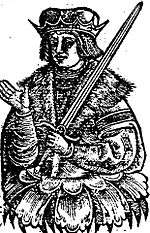 |
Wanda
| 8th century | 8th century | 8th century | Legendary daughter of Krakus | Lechites (Tribe) | 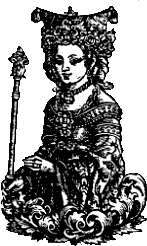 |
Leszko I
| 7th / 8th centuries | 7th / 8th centuries | 7th[5] / 8th centuries | A legendary ruler of the West Slavic ("proto-Polish") tribe of Goplans and Polans | Goplans and Polans (Tribes) | |
Leszko II
| 8th century | 8th century | 8th century | A legendary duke of Polans | Popielids | |
Leszko III
| 8th century | 8th century | 8th century | A legendary duke of Polans | Popielids | |
Popiel I
| 8th century | 8th century | 8th century | A legendary duke of Polans | Popielids | |
Popiel II
| 9th century | 9th century | 9th century | A legendary ruler dethroned by Piast. He appears (without the number) in the oldest Polish chronicle, Gesta principum Polonorum from the early XII century | Popielids | 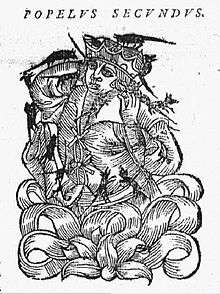 |
Piast the Wheelwright
| 9th century | 9th century | 9th century | A legendary founder of the Piast dynasty Son of Chościsko, father of Siemowit. He appears in the oldest Polish chronicle, Gesta principum Polonorum from the early XII century | Piast |
Semi-legendary dukes of the Polans in Greater Poland
Several historians tend to believe that three legendary rulers of early Poland before Mieszko I might actually be historical persons. They appear in the oldest Polish chronicle, Gesta principum Polonorum from the early 12th century.
| Name | Lifespan | Reign start | Reign end | Notes | Family | Image |
|---|---|---|---|---|---|---|
Siemowit
| 9th century | 9th century | 9th century | Son of Piast the Wheelwright and Rzepicha | Piast | |
Lestek
| 9th / 10th centuries | 9th / 10th centuries | 9th / 10th centuries | Son of Siemowit | Piast | |
Siemomysł
| 10th century | 10th century | 10th century | Son of Lestek | Piast |
Historic monarchs of Poland
Piast dukes and kings
| Name | Lifespan | Reign start | Reign end | Notes | Family | Image |
|---|---|---|---|---|---|---|
Mieszko I of Poland
| ca. 940 – 25 May 992 | ca. 960 | 992 | Son of Siemomysł First Christian Polish monarch Misico, dux Wandalorum | Piast | |
Bolesław I the Brave
| 967 – 17 June 1025 | Duke: 992 King: 18 April 1025 | Duke: 18 April 1025 King: 17 June 1025 | Son of Mieszko I and Dobrawa of Bohemia First to be crowned king Regnum Sclavorum, Gothorum sive Polonorum | Piast |  |
| Mieszko II Lambert | ca. 990 – 10/11 May 1034 | 1025 | 1031 | Son of Bolesław I and Emnilda of Lusatia | Piast | 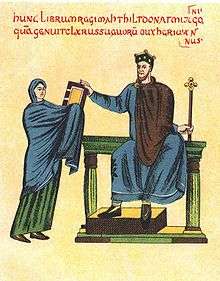 |
Bezprym
| ca. 986–1032 | 1031 | 1032 | Son of Bolesław I and Judith of Hungary | Piast | |
Otto Bolesławowic
| 1000–1033 | 1032 | 1032 | Son of Bolesław I and Emnilda | Piast | |
Dytryk
| after 992 – after 1032 | 1032 | 1032 /1033 | Grandson of Mieszko I and Oda of Haldensleben | Piast | |
Mieszko II Lambert
| ca. 990 – 10/11 May 1034 | 1032 | 1034 | Restored | Piast |  |
Bolesław the Forgotten
| before 1016 – 1038 or 1039 | 1034 | 1038 /1039 | Semi-legendary, existence disputed | Piast | |
Casimir I the Restorer
| 25 June 1016 – 28 November 1058 (aged 42) | 1039 | 1058 | Son of Mieszko II and Richeza of Lotharingia | Piast | |
Bolesław II the Generous
| ca. 1041 or 1042 – 2 or 3 April 1081 or 1082 | Duke: 1058 King: 1076 | Duke: 1076 King: 1079 | Son of Kazimierz I and Maria Dobroniega of Kiev | Piast |  |
Władysław I Herman
| ca. 1044 – 4 June 1102 | 1079 | 1102 | Son of Kazimierz I and Maria Dobroniega | Piast | 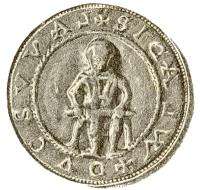 |
Zbigniew
| ca. 1073 – 8 July 1113 | 1102 | 1107 | Son of Władysław I and Przecława of Prawdzic coat of arms (disputed) First jointly with Władysław I 1098-1102 | Piast | |
Bolesław III Wrymouth
| 20 August 1086 – 28 October 1138 (aged 52) | 1107 | 1138 | Son of Władysław I and Judith of Bohemia First jointly with Władysław 1098-1102 Introduced senioral principle | Piast | 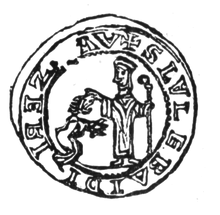 |
Fragmentation of the Kingdom of Poland, 1138–1314
Piast high dukes
| Name | Lifespan | Reign start | Reign end | Notes | Family | Image |
|---|---|---|---|---|---|---|
Władysław II the Exile
| 1105 – 30 May 1159 | 1138 | 1146 | Son of Bolesław III and Zbyslava of Kiev Also Duke of Silesia Exiled by his brothers | Piast | |
Bolesław IV the Curly
| ca. 1125 – 5 January 1173 | 1146 | 1173 | Son of Bolesław III and Salomea of Berg Also Duke of Masovia | Piast | |
Mieszko III the Old
| ca. 1127 – 13 March 1202 | 1173 | 1177 | Son of Bolesław III and Salomea Also Duke of Greater Poland | Piast |  |
Casimir II the Just
| ca. 1138 – 5 May 1194 | 1177 | 1190 | Son of Bolesław III and Salomea Also Duke of Wiślica and Sandomierz | Piast | |
Mieszko III the Old
| ca. 1127 – 13 March 1202 | 1190 | 1190 | Restored | Piast |  |
Casimir II the Just
| ca. 1138 – 5 May 1194 | 1190 | 1194 | Restored | Piast | |
Leszek I the White
| ca. 1186 – 24 November 1227 | 1194 | 1198 | Son of Casimir II and Helen of Znojmo Also Duke of Sandomierz | Piast |  |
Mieszko III the Old
| ca. 1127 – 13 March 1202 | 1198 | 1199 | Restored | Piast |  |
Leszek I the White
| ca. 1186 – 24 November 1227 | 1199 | 1199 | Restored | Piast | |
Mieszko III the Old
| ca. 1127 – 13 March 1202 | 1199 | 1202 | Restored | Piast |  |
Władysław III Spindleshanks
| ca. 1161/66 – 3 November 1231 | 1202 | 1202 | Son of Mieszko III and Eudoxia of Kiev Also Duke of Greater Poland | Piast | |
Leszek I the White
| ca. 1186 – 24 November 1227 | 1202 | 1210 | Restored | Piast |  |
Mieszko IV Tanglefoot
| ca. 1130 – 16 May 1211 | 1210 | 1211 | Son of Władysław II and Agnes of Babenberg Also Duke of Silesia | Piast | |
Leszek I the White
| ca. 1186 – 24 November 1227 | 1211 | 1225 | Restored | Piast |  |
Henryk I the Bearded
| ca. 1165 – 19 March 1238 | 1225 | 1225 | Grandson of Władysław II, son of Bolesław I the Tall and Krystyna Also Duke of Silesia | Piast |  |
Leszek I the White
| ca. 1186 – 24 November 1227 | 1225 | 1227 | Restored Assassinated | Piast |  |
Władysław III Spindleshanks
| ca. 1161/66 – 3 November 1231 | 1227 | 1229 | Restored | Piast | |
Konrad I of Masovia
| ca. 1187/88 – 31 August 1247 | 1229 | 1232 | Son of Kazimierz II and Helen of Znojmo Also Duke of Masovia | Piast |  |
Henryk I the Bearded
| ca. 1165 – 19 March 1238 | 1232 | 1238 | Restored | Piast |  |
Henryk II the Pious
| ca. 1196 – 9 April 1241 | 1238 | 1241 | Son of Henry I and Saint Hedwig of Andechs (Saint Hedwig of Silesia) Slso Duke of Wroclaw and Greater Poland Fell at Battle of Legnica | Piast | |
Bolesław II the Horned
| ca. 1220–1278 | 1241 | 1241 | Son of Henry II and Anne of Bohemia Also Duke of Silesia | Piast | |
Konrad I of Masovia
| ca. 1187/88 – 31 August 1247 | 1241 | 1243 | Restored | Piast |  |
Bolesław V the Chaste
| 21 June 1226 – 7 December 1279 | 1243 | 1279 | Son of Leszek the White and Grzymislawa of Luck | Piast |  |
Leszek II the Black
| ca. 1241 – 30 September 1288 | 1279 | 1288 | Grandson of Konrad I of Masovia Maternal grandson of Henry II Son of Casimir I of Kuyavia and Constance of Wrocław | Piast | 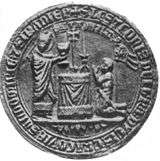 |
Bolesław II of Masovia
| ca. 1251 – 20 April 1313 | 1288 | 1288 | Grandson of Konrad I of Masovia Duke of Masovia | Piast |  |
Henryk IV Probus
| ca. 1257/58 – 23 June 1290 | 1288 | 1289 | Paternal grandson of Henryk II Maternal grandson of Konrad I Son of Henry III the White and Judyta of Masovia Duke of Lower Silesia | Piast |  |
Bolesław II of Masovia
| ca. 1251 – 20 April 1313 | 1289 | 1289 | Restored | Piast |  |
Władysław I the Elbow-high
| 1261 – 2 March 1333 | 1289 | 1289 | Grandson of Konrad I of Masovia Son of Kazimierz I of Kujawia and Euphrosyne of Opole | Piast |  |
Henryk IV Probus
| ca. 1257/58 – 23 June 1290 | 1289 | 1290 | Restored | Piast |  |
Reunification attempts in the Kingdom of Poland 1232–1305
Piast kings
| Name | Lifespan | Reign start | Reign end | Notes | Family | Image |
|---|---|---|---|---|---|---|
Przemysł II
| 14 October 1257 – 8 February 1296 (aged 38) | High Duke: 1290 King: 1295 | High Duke: 1291 King: 1296 | Grandson of Henryk II Son of Przemysł I and Elisabeth of Wrocław Also Duke of Poznań, Greater Poland and Pomerania | Piast |
Přemyslid kings
| Name | Lifespan | Reign start | Reign end | Notes | Family | Image |
|---|---|---|---|---|---|---|
Wenceslaus II of Bohemia
| 27 September 1271 – 21 June 1305 (aged 33) | High Duke: 1291 King: 1300 | High Duke: 1300 King: 1305 | Son of Ottokar II of Bohemia and Kunigunda of Slavonia Married Przemysł II's daughter Elisabeth Richeza of Poland Also King of Bohemia | Přemyslid |  |
Wenceslaus III of Bohemia
| 6 October 1289 – 4 August 1306 (aged 16) | 1305 | 1306 | Son of Wenceslaus II and Judith of Habsburg Uncrowned Assassinated | Přemyslid |  |
Reunited Kingdom of Poland, 1314–1569
Piast kings
| Name | Lifespan | Reign start | Reign end | Notes | Family | Image |
|---|---|---|---|---|---|---|
Władysław I the Elbow-high
| 1261 – 2 March 1333 | 1320 | 1333 | Restored Re-united the Kingdom of Poland | Piast |  |
Casimir III the Great
| 30 April 1310 – 5 November 1370 (aged 60) | 1333 | 1370 | Son of Władysław I the Elbow-high and Jadwiga of Kalisz Regarded as one of the greatest Polish monarchs | Piast |  |
Anjou kings
| Name | Lifespan | Reign start | Reign end | Notes | Family | Image |
|---|---|---|---|---|---|---|
Louis I of Hungary
| 5 March 1326 – 10 September 1382 (aged 56) | 1370 | 1382 | Son of Charles I of Hungary and Elizabeth of Poland Nephew of Casimir III Elected king and crowned on 17 November Also King of Hungary | Anjou | .jpg) |
Jadwiga of Poland
| 1373/4 – 17 July 1399 | 16 October 1384 | 17 July 1399 | Daughter of Louis I and Elizabeth of Bosnia Crowned king to emphasize her monarchical status, 1384 Reigned jointly with her husband Władysław II Jagiełło from 1386 | Anjou | .jpg) |
Jagiellonian kings
| Name | Lifespan | Reign start | Reign end | Notes | Family | Image |
|---|---|---|---|---|---|---|
Władysław II Jagiełło
| ca. 1351/1362 – 1 June 1434 | 4 March 1386 | 1 June 1434 | Son of Algirdas of Lithuania and Uliana of Tver Grand Duke of Lithuania, 1377-1434 Reigned jointly with his wife Jadwiga till 1399 The longest-reigning King of Poland | Jagiellonian | .jpg) |
Władysław III of Poland
| 31 October 1424 – 10 November 1444 (aged 20) | 25 July 1434 | 10 November 1444 | Son of Władysław II Jagiełło and Sophia of Halshany Also king of Hungary, as Ulászló I Fell at Battle of Varna, in Bulgaria, hence called "of Varna" | Jagiellonian | |
Casimir IV Jagiellon
| 30 November 1427 - 7 June 1492 (aged 64) | 25 June 1447 | 7 June 1492 | Son of Władysław II and Sophia of Halshany Also Grand Duke of Lithuania, 1440–92 His successful reign ended in the final destruction of the Teutonic Knights | Jagiellonian | .jpg) |
John I Albert
| 27 December 1459 – 17 June 1501 (aged 41) | 23 September 1492 | 16 June 1501 | Son of Casimir IV and Elisabeth of Austria | Jagiellonian |  |
Alexander I Jagiellon
| 5 August 1461 – 19 August 1506 (aged 45) | 12 December 1501 | 19 August 1506 | Son of Casimir IV and Elisabeth of Austria Also Grand Duke of Lithuania 1492-1506 | Jagiellonian | .jpg) |
Sigismund I the Old
| 1 January 1467 – 1 April 1548 (aged 81) | 8 December 1506 | 1 April 1548 | Son of Casimir IV and Elisabeth of Austria Also Grand Duke of Lithuania Forced Prussian Homage in 1525 Annexed Duchy of Masovia in 1526 Entered alliance with Maximilian I, Holy Roman Emperor | Jagiellonian | 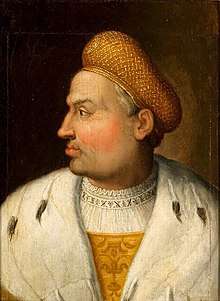 |
Sigismund II Augustus
| 1 August 1520 – 7 July 1572 (aged 51) | 1 April 1548 | 7 July 1572 | Son of Sigismund I and Bona Sforza Also Grand Duke of Lithuania Replaced the personal union of the Kingdom of Poland and the Grand Duchy of Lithuania with a real union and an elective monarchy (Polish–Lithuanian Commonwealth) in 1569 | Jagiellonian |  |
Polish–Lithuanian Commonwealth, 1569–1795
| Name | Lifespan | Reign start | Reign end | Notes | Family | Image |
|---|---|---|---|---|---|---|
Henry de Valois
| 19 September 1551 – 2 August 1589 (aged 37) | 21 February 1574 | 12 May 1575 | Son of Henry II of France and Catherine de' Medici Abandoned the Polish throne three months after his coronation in order to become King of France | Valois |  |
Anna
| 18 October 1523 – 9 September 1596 (aged 72) | 15 December 1575 | 12 December 1586 | Daughter of Sigismund I and Bona Sforza Reigned together with her husband Stephen Báthory | Jagiellonian |  |
Stephen Báthory
| 27 September 1533 – 12 December 1586 (aged 53) | 15 December 1575 | 12 December 1586 | Son of Stephen VIII Báthory and Catherine Telegdi Prince of Transylvania Reigned together with his wife Anna | Báthory | _01.jpg) |
Sigismund III
| 20 June 1566 – 30 April 1632 (aged 65) | 18 September 1587 | 19 April 1632 | Grandson of Sigismund I Son of John III of Sweden and Catherine Jagiellon Also King of Sweden 1592-1599, titular King 1599–1632 During his reign Polish troops captured Moscow Moved capital from Kraków to Warsaw | Vasa | 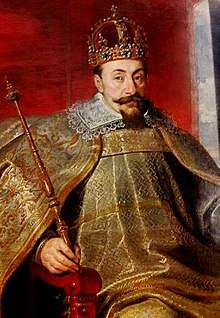 |
Władysław IV
| 9 June 1595 – 20 May 1648 (aged 52) | 8 November 1632 | 20 May 1648 | Son of Sigismund III and Anne of Austria Titular Tsar of Russia 1610–1634, titular King of Sweden 1632–1648 | Vasa |  |
John II Casimir
| 22 March 1609 – 16 December 1672 (aged 63) | 20 November 1648 | 16 September 1668 | Son of Sigismund III and Constance of Austria Titular King of Sweden 1648-1660 Abdicated | Vasa | 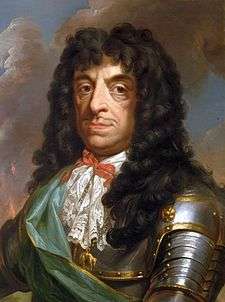 |
Michael I
| May 31, 1640 – November 10, 1673 (aged 33) | 19 June 1669 | 10 November 1673 | Son of a successful but controversial military commander, Jeremi Wiśniowiecki, and Gryzelda Konstancja Zamoyska | Wiśniowiecki |  |
John III
| 17 August 1629 – 17 June 1696 (aged 66) | 21 May 1674 | 17 June 1696 | Son of Jakub Sobieski and Zofia Teofillia Daniłowicz Most famous for his brilliant victory over the Turks at the Battle of Vienna in 1683 | Sobieski | 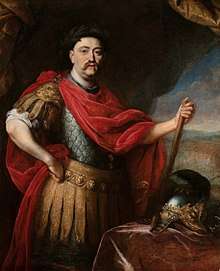 |
Augustus II the Strong
| 12 May 1670 – 1 February 1733 (aged 62) | 15 September 1697 | 16 February 1704 (deposed) 24 September 1706 (abdicates) | Son of John George III and Anna Sophie of Denmark Elector of Saxony as Frederick Augustus I, 1694–1733 | Wettin | |
Stanisław I
| 20 October 1677 – 23 February 1766 (aged 88) | 4 October 1705 | 8 August 1709 | Son of Rafał Leszczyński and Anna Jabłonowska Yielded to Augustus II | Leszczyński |  |
Augustus II the Strong
| 12 May 1670 – 1 February 1733 (aged 62) | 8 August 1709 | 1 February 1733 | Restored | Wettin | |
Stanisław I
| 20 October 1677 – 23 February 1766 (aged 88) | 12 September 1733 | 30 June 1734 (deposed) 27 January 1736 (abdicates) | Restored Defeated in War of the Polish Succession Became Duke of Lorraine until his death | Leszczyński |  |
Augustus III
| 17 October 1696 – 5 October 1763 (aged 66) | 17 January 1734 (in opposition) 30 June 1734 (effectively) | 5 October 1763 | Son of Augustus II and Christiane Eberhardine of Brandenburg-Bayreuth | Wettin | |
Stanisław II Augustus
| 17 January 1732 – 12 February 1798 (aged 66) | 25 November 1764 | 7 January 1795 | Son of Stanisław Poniatowski and Konstancja Czartoryska Forced to abdicate when the Polish–Lithuanian Commonwealth (a hereditary monarchy since May 3, 1791) ceased to exist | Poniatowski |  |
Duchy of Warsaw, 1807–1815
| Name | Lifespan | Reign start | Reign end | Notes | Family | Image |
|---|---|---|---|---|---|---|
Frederick Augustus I
| 23 December 1750 – 5 May 1827 (aged 76) | 9 June 1807 | 22 May 1815 | Son of Frederick Christian, Elector of Saxony and Duchess Maria Antonia of Bavaria Duke of Warsaw Designated as a king of Poland by General Confederation of the Kingdom of Poland, 1812. | Wettin |  |
Pretenders to the Polish throne
Part of a series on the |
||||||||||
|---|---|---|---|---|---|---|---|---|---|---|
| History of Poland | ||||||||||
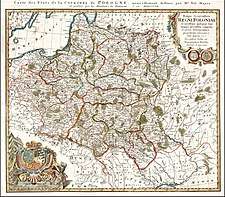 | ||||||||||
|
|
||||||||||
|
||||||||||
|
||||||||||
|
||||||||||
|
||||||||||
|
| ||||||||||
- Vratislaus II of Bohemia (1085–1092)
- Rudolf I of Bohemia (1306–1307)
- Henry of Bohemia (1307–1310)
- John of Bohemia (1310–1335)
Not recognized royal elections
- Maxmilian II Habsburg (1575–1576), See: 1576 Free election
- Maxmilian III Habsburg (1587–1589), See: 1587 Free election
- François Louis de Bourbon (1697), See: 1697 Free election
See also
- Kings of Poland family tree
- Coronations in Poland
- Princely Houses of Poland
- Dukes of Greater Poland
- Dukes of Masovia
- Dukes of Pomerania
- Dukes of Sieradz-Łęczyca
- Dukes of Silesia
- List of rulers of Partitioned Poland
- List of Galician rulers
- List of heads of state of Poland
- List of Prime Ministers of Poland
- List of Poles
- List of Polish consorts
References
- It was not allowed to use abbreviations and acronyms
- In the 17th century and later Poland was usually known as the Most Serene Republic of Poland (Polish: Najjaśniejsza Rzeczpospolita Polska, Latin: Serenissima Res Publica Poloniae).
- Since 1574
- http://www.ampolinstitute.org/pdf/Polish-Kings.pdf
- dated around 700 by Marcin Bielski
- Anna was crowned King of Poland
Bibliography
- Duczmal M., Jagiellonowie. Leksykon biograficzny, Kraków 1996.
- Dybkowska A., Żaryn J., Żaryn M., Polskie dzieje. Od czasów najdawniejszych po współczesność, wyd. 2, Warszawa 1995. ISBN 83-01-11870-9
- Gierowski J.A., Rzeczpospolita w dobie złotej wolności (1648–1763), Kraków 2001. ISBN 83-85719-56-3
- Grodziski S., Polska w czasach przełomu (1764–1815), Kraków 2001. ISBN 83-85719-45-8
- Grodziski S., Porównawcza historia ustrojów państwowych, Kraków 1998. ISBN 83-7052-840-6
- Grzybowski S., Dzieje Polski i Litwy (1506–1648), Kraków 2000. ISBN 83-85719-48-2
- Morby J.E., Dynastie świata. Przewodnik chronologiczny i genealogiczny, Kraków 1995, s. 261-263. ISBN 83-7006-263-6
- Wyrozumski J., Dzieje Polski piastowskiej (VIII w.-1370), Kraków 1999. ISBN 83-85719-38-5
- Zientara B., Henryk Brodaty i jego czasy, wyd. 2, Warszawa 1997.
External links
| Wikimedia Commons has media related to Kings and dukes of Poland. |
- Górczyk, Wojciech, "Półksiężyc, orzeł, lew i smok. Uwagi o godłach napieczętnych Piastów" Histmag.org June 14, 2009

